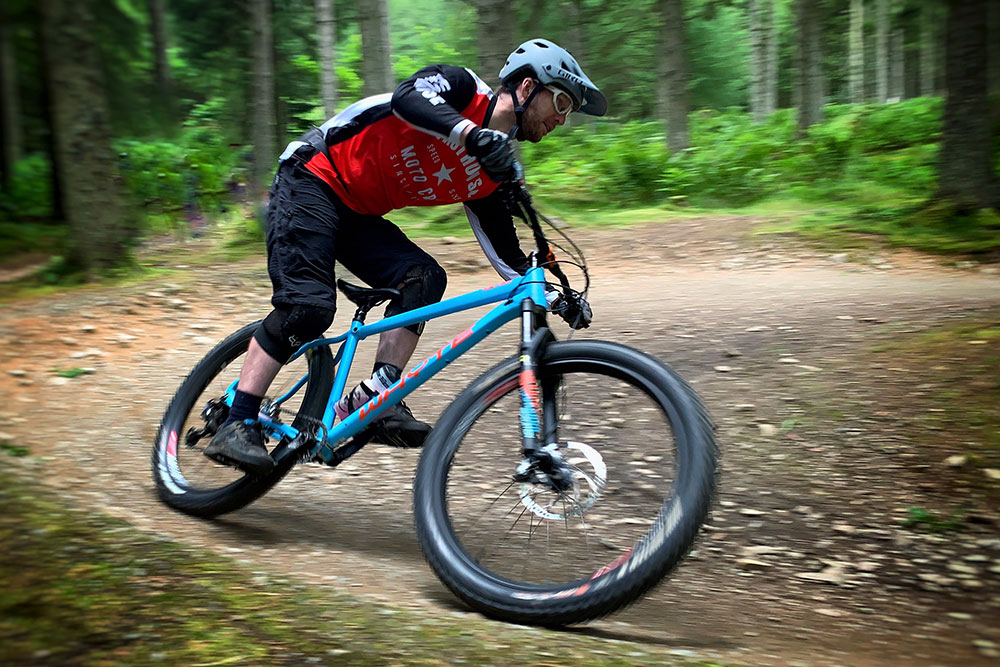


Are you a beginner who is eager to embark on the exciting journey of mountain biking? If so, you’ve come to the right place! Learning how to ride a mountain bike can be an exhilarating and rewarding experience.
Read More : ” Why Are Downhill Bikes So Expensive? “
Whether you’re seeking thrilling adventures in nature or looking to improve your fitness, mountain biking offers a unique blend of physical challenge and outdoor exploration.
In this comprehensive guide, we will provide you with valuable insights and essential tips on how to ride a mountain bike for beginners. From the basics of bike setup and body positioning to mastering fundamental riding techniques, we will cover everything you need to know to get started on the right foot.
Riding a mountain bike involves more than just pedaling and steering. It requires a combination of balance, control, and adaptability to navigate varying terrains and obstacles. By understanding the proper techniques and building your skills gradually, you can enhance your confidence and enjoyment on the trails.
So, if you’re ready to embark on an exciting mountain biking journey, let’s dive in and discover the essential knowledge and skills you need to ride a mountain bike as a beginner. Let’s explore the world of mountain biking together and unlock the thrills and adventures that await you!
Read More : ” Can You Use A Hybrid Bike For Mountain Biking? “
Bike Setup: Ensuring the Right Fit and Comfort
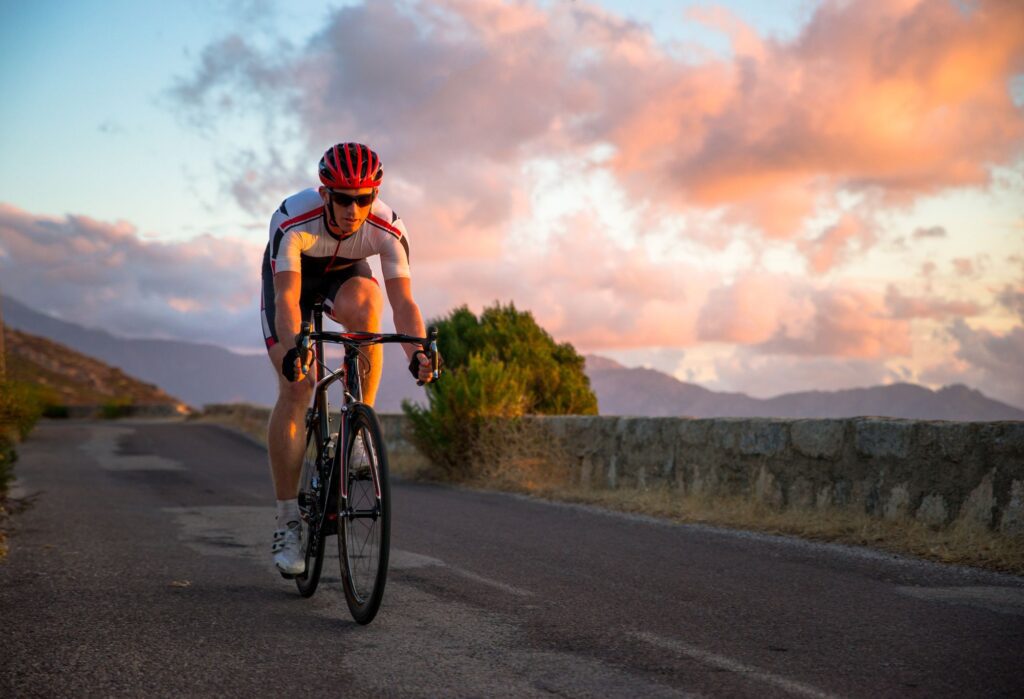


“Finding the perfect bike setup is the key to unlocking a world of comfort and confidence. Customize your ride to fit your body, and let the bike become an extension of your own movements.”
Setting up your mountain bike properly is crucial for a comfortable and enjoyable riding experience. The right fit and comfort level will not only enhance your performance but also minimize the risk of injury.
Here are some essential factors to consider when setting up your mountain bike:
Frame Size:
Start by choosing the right frame size that suits your body proportions. A properly sized frame ensures proper reach and balance while riding.
Saddle Height:
Adjust the saddle height so that your leg is almost fully extended at the bottom of the pedal stroke. This allows for efficient power transfer and reduces strain on your knees.
Handlebar Position:
Find a handlebar position that provides a comfortable reach and allows for proper body alignment. Experiment with different stem lengths and handlebar heights to find your sweet spot.
Suspension Setup:
If your mountain bike has suspension, adjust it according to your weight and riding preferences. Fine-tune the sag and damping settings to ensure optimal performance and comfort on various terrains.
Ergonomic Grips and Pedals:
Consider using ergonomic grips that provide better hand support and minimize fatigue. Additionally, choose pedals that offer a secure grip and match your riding style.
Proper Clothing and Gear:
Wear appropriate clothing and protective gear that enhances comfort and safety. Invest in padded shorts, moisture-wicking jerseys, and a well-fitting helmet.
By paying attention to bike setup, you can create a personalized riding experience tailored to your body and riding style. A comfortable and properly fitted mountain bike will enable you to ride longer, explore new trails, and make the most of your off-road adventures.
So take the time to fine-tune your bike setup and enjoy the ride!
Read More : ” Can Mountain Bike Be Used On Snow? “
Body Positioning: Maintaining Balance and Control
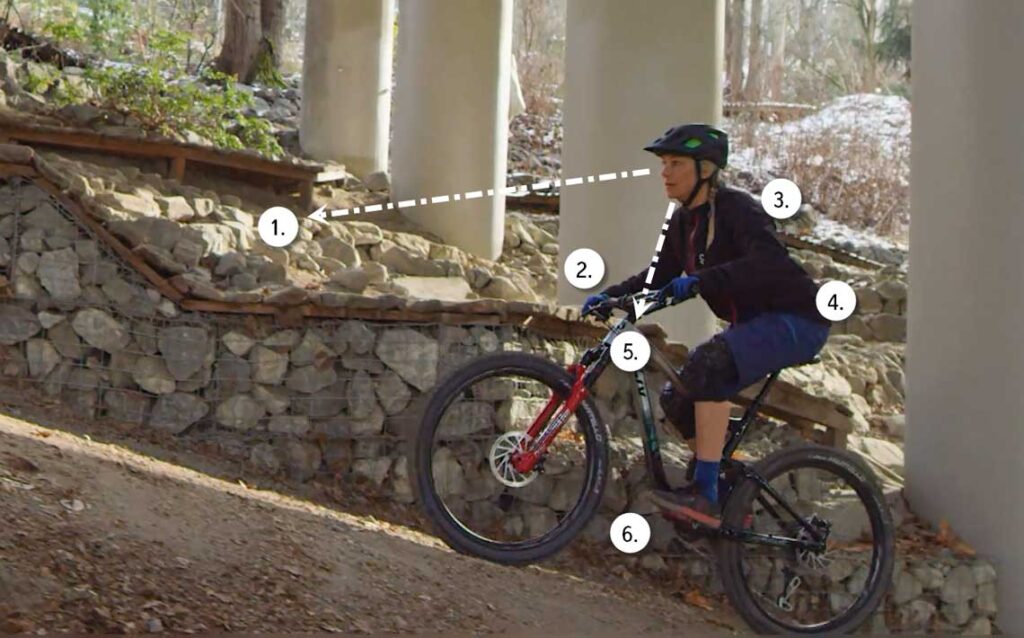


“Mastering body positioning on a mountain bike is like finding your center of gravity. By staying balanced and in control, you’ll unleash the true potential of your ride and conquer any trail that comes your way.”
Proper body positioning is a fundamental aspect of riding a mountain bike. It not only helps you maintain balance and control but also improves your overall riding performance. Whether you’re a beginner or an experienced rider, understanding and practicing the correct body positioning techniques can significantly enhance your mountain biking experience.
Here are some key points to consider:
Neutral Riding Position:
- Start by establishing a neutral riding position, which forms the foundation for maintaining balance and control.
- Keep your knees and elbows slightly bent, and distribute your weight evenly on both pedals.
Eyes Up and Forward:
Look ahead and keep your eyes focused on the trail, rather than directly in front of your bike. This allows you to anticipate obstacles and adjust your riding line accordingly.
Weight Distribution:
- Shift your body weight as needed to maintain balance and control.
- For climbs, shift your weight forward to keep traction on the front wheel.
- For descents, shift your weight back to improve stability and prevent the front wheel from lifting.
Braking Technique:
When applying the brakes, shift your weight slightly back to prevent your front wheel from skidding. Gradually and evenly apply both brakes for a controlled stop.
Cornering Technique:
While cornering, lean your body and bike into the turn, with your outside foot down and your inside knee out. This lowers your center of gravity and allows for better traction and stability.
Body Movements:
Use your body to absorb impacts and navigate technical sections. Practice using your arms and legs as suspension, allowing them to flex and extend to maintain contact with the terrain.
By mastering these body positioning techniques, you’ll feel more confident and in control on the trails. Remember to practice them consistently and adjust them based on different terrains and riding conditions.
With time and experience, you’ll develop a natural instinct for maintaining balance and control, making your mountain biking adventures safer and more enjoyable.
Read More : ” Can You Ride A Mountain Bike On Street? “
Braking and Shifting: Mastering the Basics
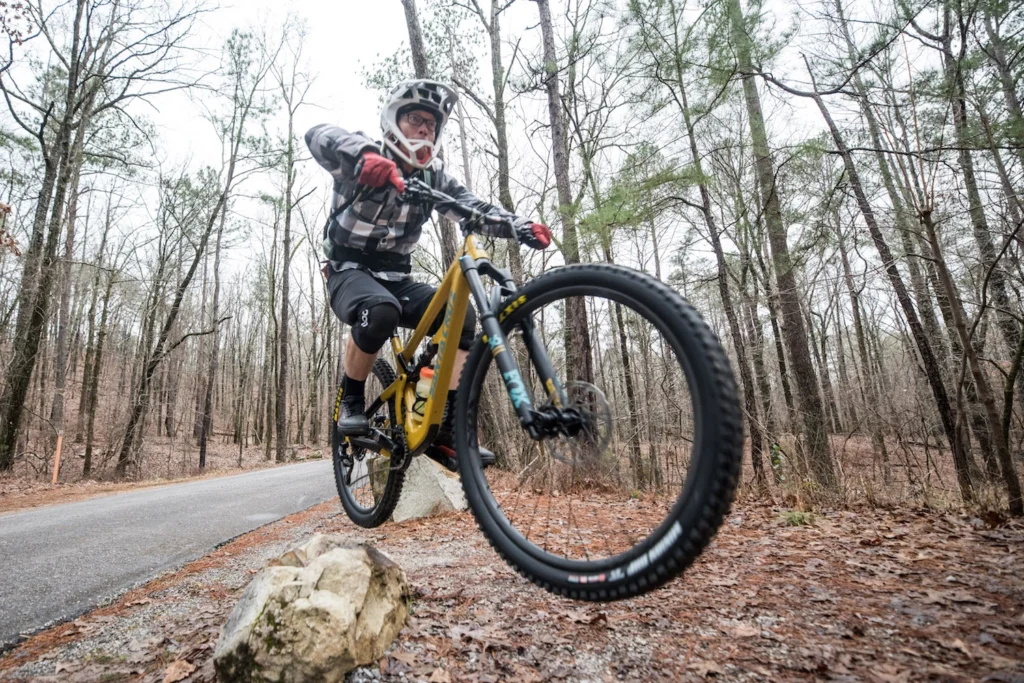


“Braking and shifting are the rhythm of mountain biking. With precise control over your bike’s speed and gear selection, you’ll flow through the trails with confidence and efficiency, taking your riding to the next level.”
Effective braking and shifting are important skills for any mountain biker, especially a beginner. Knowing the proper technique and how to use your bike’s brakes and gears can improve your cycling experience and keep you safer on the road.
Here are some key points for learning the basics of braking and shifting:
Braking technique:
- Use both brakes at the same time. Apply equal pressure to the front and rear brakes to increase stopping power and prevent spin. »
- Smooth and controlled braking. Avoid sudden braking, which can lead to loss of grip and a crash. Instead, apply the brakes slowly for a smooth, controlled stop.
- Weight distribution. Shift your weight slightly back when braking to prevent front wheel spin and maintain stability.
Change the speed:
- Wait until the position changes. To maintain a comfortable pedaling speed, slow down before riding. Move up when approaching a slope or driving on level ground.
- Quiet movement. Avoid cross-chaining by shifting one gear at a time, which can stress the motor (use a larger chainring on a larger rear bar, and vice versa).
- Pedal pressure. Reduce pedal pressure slightly when shifting for a smoother shift.
Training and introduction:
- Find open spaces or technical trails to practice braking and handling techniques.
- Gradually increase your speed and challenge yourself with different driving situations.
- Try different hand positions and put your finger on the brake lever, find a comfortable position, and access brakes and lines quickly and easily.
Remember, mastering the basics of braking and shifting takes time and practice. Start with slow, controlled movements and gradually build your skills and confidence. Regularly inspect and maintain your bike’s braking system and drive train to ensure maximum performance.
By mastering these basic skills, you will be able to better control your mountain bike and be prepared for different trail conditions and challenges.
Read More : ” How To Take Care Of A Mountain Bike? “
Pedaling technique: efficient power and speed
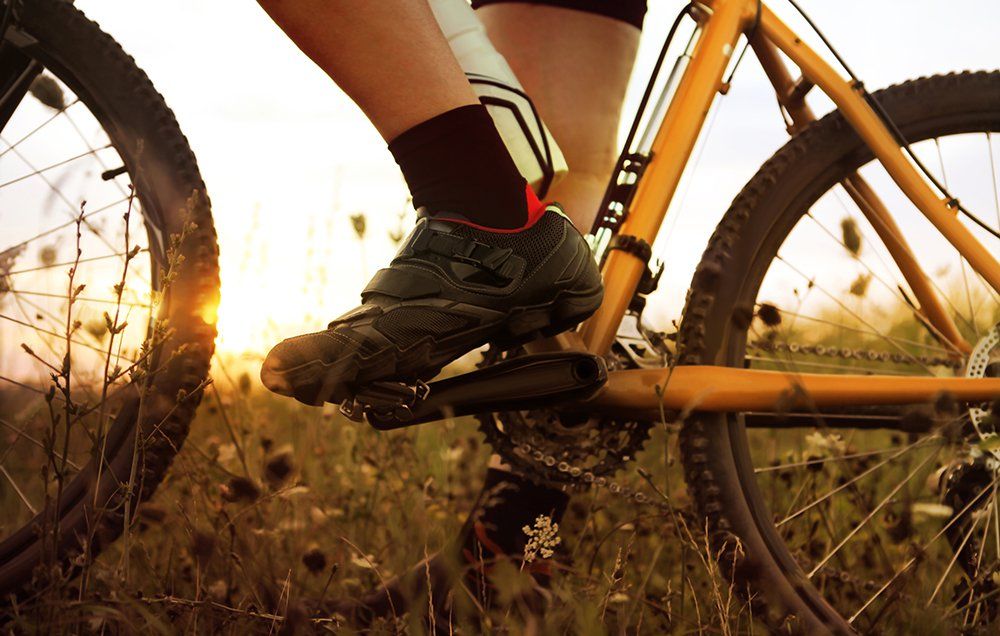


“Braking and shifting are the rhythm of mountain biking. With precise control over your bike’s speed and gear selection, you’ll flow through the trails with confidence and efficiency, taking your riding to the next level.”
Pedaling is a key skill in mountain biking and directly affects speed, endurance, and overall performance on the trail. Learning proper pedaling techniques will help you maximize your power output and maintain a consistent speed, resulting in a smoother ride and better performance.
Here are some key tips for effective pedaling.
Pedals with rims:
- Aim for a smooth circular motion during the pedal stroke, rather than just stepping on the pedal.
- Focus on the power of your forward and backward strides, as well as when your feet are on the top or bottom of your kick.
Stay consistent:
- Cadence refers to how fast you pedal and is measured in revolutions per minute (RPM).
- Find a speed that feels comfortable and efficient for you. The recommended range for mountain bikes is usually 70-90.
- Adjust gear selection to suit the terrain and maintain a constant speed. Shift to a lower gear when climbing steep hills and to a higher gear when climbing flat hills or going downhill.
Use the correct body position:
- Strengthen your core muscles to stabilize your upper body and maintain balance.
- Relax your upper body and shoulders and let your arms act as shock absorbers.
- Slightly bend your knees and elbows to absorb shock and maintain a smooth ride.
Find out how to change your efforts:
- Change your approach depending on where you are. Uses more power on tough climbs and smoothes out on descents and flat sections.
- Applies efficient power transfer by adjusting effort according to trail conditions.
Perform pedal strokes on a variety of terrains:
- Practice your pedaling technique on a variety of terrain including climbs, descents, and technical sections.
- Notice how your body position, speed, and power adapt to different riding situations.
A focus on proper pedaling technique can increase efficiency, save energy, and enhance your overall mountain biking experience. Constant practice and a conscious effort to maintain a smooth ride will help you improve your speed, endurance, and control on the trail.
Don’t forget to combine these pedaling techniques with other basic skills like body positioning, braking, and shifting to become a well-rounded, well-rounded mountain biker.
Read More : ” Can You Ride A Mountain Bike On Pavement? “
Route awareness: read the terrain and choose the path
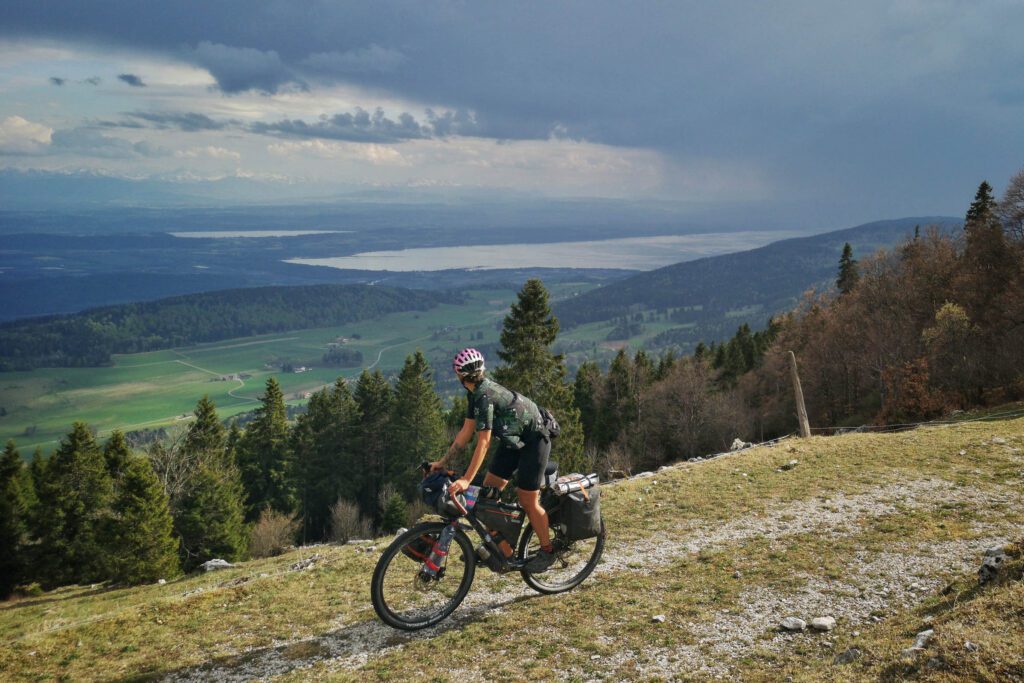


“Route awareness is the key to conquering any trail. By reading the terrain and choosing the right path, you’ll navigate through obstacles with finesse, finding the perfect line that leads to an exhilarating ride.”
One of the key skills for new mountain bikers is trail awareness – the ability to read the terrain and make decisions about the best path to take. By improving these skills, you can improve your driving efficiency, safety, and overall enjoyment on the track.
Here are some tips for increasing route awareness:
Look forward:
- Keep your eyes on the road, not directly in front of your steering wheel.
- Anticipate future obstacles, turns and terrain changes to better plan your path selection and adapt your driving technique.
Land assessment:
- Pay attention to surface conditions such as rocks, roots, gravel, or sand.
- Identify potential hazards or obstacles that may require adjustments in speed, lane selection, or body position.
Choose the best path:
- Evaluate multiple path options on your route and select the one that offers the smoothest and most efficient route.
- Find the path with the fewest obstacles, optimal traction, and the best flow.
Learn to read features:
- Improve your ability to analyze track features such as shoulders, jumps, drops, or technical sections.
- Understand how these characteristics affect your bike’s trajectory, speed, and stability, and adjust your riding technique accordingly.
Adapt to changing conditions:
- Track conditions may change as you ride, including changes in terrain, weather, and lighting.
- Stay alert and adapt your driving approach to current conditions for maximum safety and enjoyment.
Practice a different course:
- Drive on different tracks with different difficulties and characteristics to improve your trail awareness skills.
- Each course offers unique challenges and opportunities to improve your ability to read the terrain and choose the best path.
By developing a strong knowledge of the trails, you can become a more confident and experienced mountain biker. With practice, you’ll be able to read the terrain, make quick decisions, and pick the most efficient path, resulting in a smoother ride and better overall performance.
Remember to always put safety first, improve your skills gradually and have fun exploring the many trails that mountain biking has to offer.
Read More : ” Is Mountain Biking Safe? “
Climbs and Descents: Master the climbs and descents
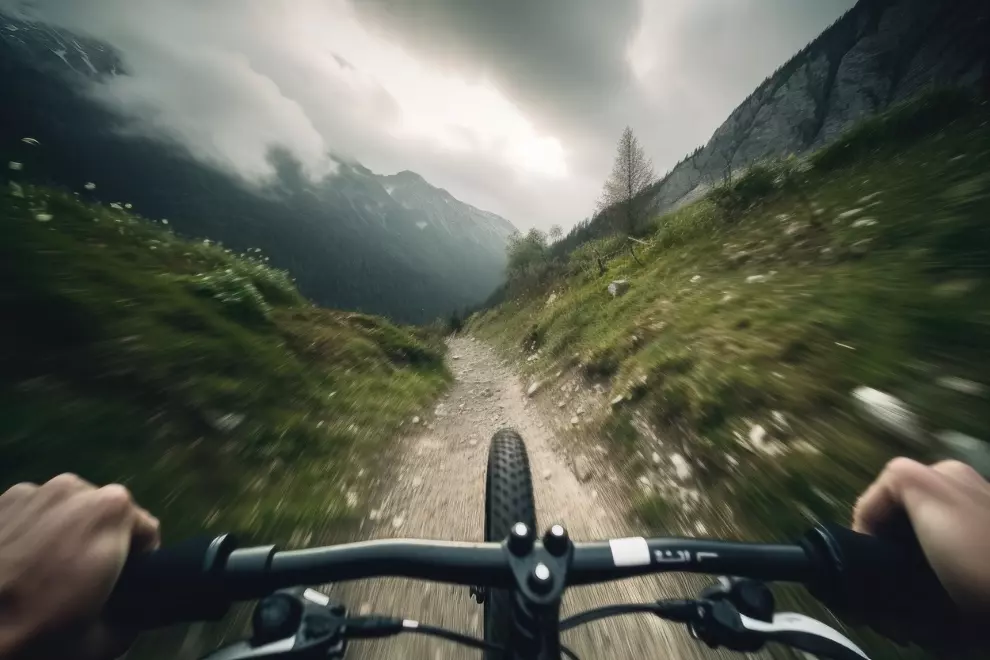


“Climbs and descents are the ultimate test of a mountain biker’s skill and determination. Conquer the uphill battles and embrace the thrilling descents, for it is in these moments that you truly become one with your bike and the terrain.”
Mountain biking covers a huge range of terrain and mastering the art of climbing and descending is essential for every rider. Whether you’re tackling steep hills or navigating fast descents, understanding technique and having the right skills will dramatically improve your mountain biking experience.
Here is a complete guide to getting on and off your mountain bike:
Climbing techniques:
Speed Selection:
Select an appropriate speed that allows you to maintain a steady pace without overworking.
Weight Distribution:
Shifts weight forward to maintain front wheel traction and prevent wheel spin.
Smooth Pedaling:
Focus on a steady pedal stroke and avoid sudden surges of force to maintain traction and control.
Path Selection:
Find the path of least resistance, avoiding rocks, roots, or obstacles that may hinder your progress.
Maintain momentum:
Wear the right gear while climbing and try to maintain momentum to make negotiating steep sections easier.
Descending technique:
Body position:
Shift your weight back and lower your center of gravity for more stability and control.
Braking:
Use the front and rear brakes wisely to maintain control and modulate your speed.
Line Selection:
Choose the smoothest and safest line, avoiding loose rocks, deep ruts, or other potential hazards.
Vision and Anticipation:
Anticipate changes in terrain and react accordingly to maintain a smooth descent.
Relax and stay out:
Maintain a relaxed grip on the handlebars and let your bike sink under you, allowing it to soak up bumps and obstacles.
The importance of uphill and downhill skills:
Mastering ascent and descent techniques is important for several reasons:
Efficiency:
Proper technique helps conserve energy on climbs and allows you to maintain momentum, saving you wasted effort.
Safety:
Having the proper skills and techniques will minimize the risk of an accident or loss of control when descending a rough road or steep grade.
Confidence:
Developing this skill boosts your confidence on the trail, allowing you to tackle tougher terrain and explore new riding opportunities.
Fun:
With improved climbing and descending capabilities, you’ll have a greater sense of control, allowing you to fully experience the fun and freedom that mountain biking has to offer.
Remember that climbing and descending techniques require practice and experience. Start with moderate trails and gradually progress to more difficult terrain as your confidence and skills increase.
Always put safety first, wear the proper protective gear, and consider trail and weather conditions. With time and dedication, you will become an expert rock climber and climber, ready to conquer any mountain biking adventure that comes your way.
Read More : ” Is Mountain Bike Good For Beginners? “
Cornering: Get around corners with confidence
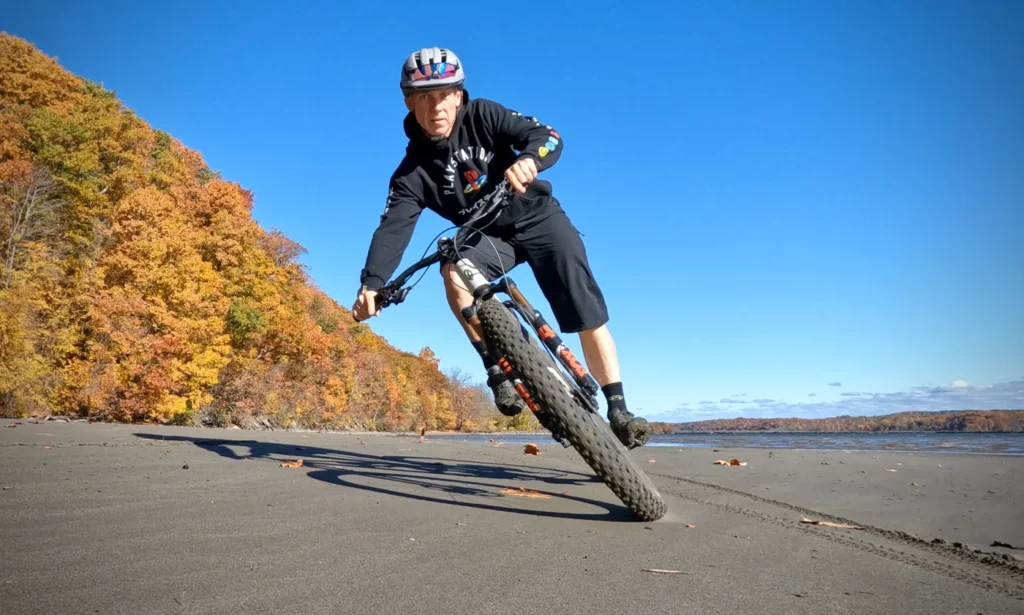


“Climbs and descents are the ultimate test of a mountain biker’s skill and determination. Conquer the uphill battles and embrace the thrilling descents, for it is in these moments that you truly become one with your bike and the terrain.”
Cornering is an essential mountain bike skill that allows you to maintain speed, control, and stability while navigating corners. Whether you’re negotiating tight gear shifts or flowing berms, mastering the art of cornering will dramatically enhance your driving experience.
Here’s a complete guide to tackling corners on a mountain bike:
Body position:
Weight Distribution:
Allows tires to maintain traction by shifting body weight out of bends.
Lower your center of gravity:
Bend your knees and elbows and lean toward the bike to increase balance.
Look around corners:
Focus your eyes ahead and see where you want to go, not directly in front of the wheel.
Approach and introduction:
Choose the right road:
Analyze the bends, evaluate the terrain, and choose the best road that offers the smoothest and fastest route.
Adjust your speed:
Take turns at an appropriate speed, making sure you have enough control to navigate smoothly.
Brake Before Turning:
If necessary, brake before the turn to control your speed, but release the brakes as you enter the turn.
Execution:
Tilt the bike to its side:
Tilt the bike into a corner, maintaining a stable position while keeping your upper body straight.
Maintain traction:
Apply equal pressure to the front and rear tires, avoiding sudden or excessive braking or acceleration.
Control your line:
Use your body weight and handlebar motion to steer the bike along your chosen line.
Smooth pedal stroke:
Maintain a steady pedaling speed and avoid sudden power spikes that can cause loss of traction.
The importance of cornering skills:
Mastering the cornering technique is important for several reasons:
Speed and Efficiency:
Correct cornering technique allows you to maintain speed throughout the turn, helping you conserve momentum and save energy.
Control and Stability:
By understanding how to distribute weight and maintain traction, you can confidently navigate corners while maintaining control.
Safety:
Cornering capabilities improve overall lane safety by reducing the risk of skidding or loss of control.
Flow and fun:
Smooth, precise bends increase the flow of your ride, making it more fun and satisfying.
Remember that cornering skills improve with practice and experience. Start by making big, smooth turns before moving on to tighter, more technical turns. Experiment with different line options and gradually increase your speed as your confidence grows.
Always put safety first, wear appropriate protective gear, and consider road conditions. With time and dedication, you will become a competent cornering rider, confidently navigating every corner you encounter and adding new levels of excitement to your mountain biking adventures.
Read More : ” What Do I Need To Start Mountain Biking? “
Business: Facing Rocks, Roots, and Other Challenges
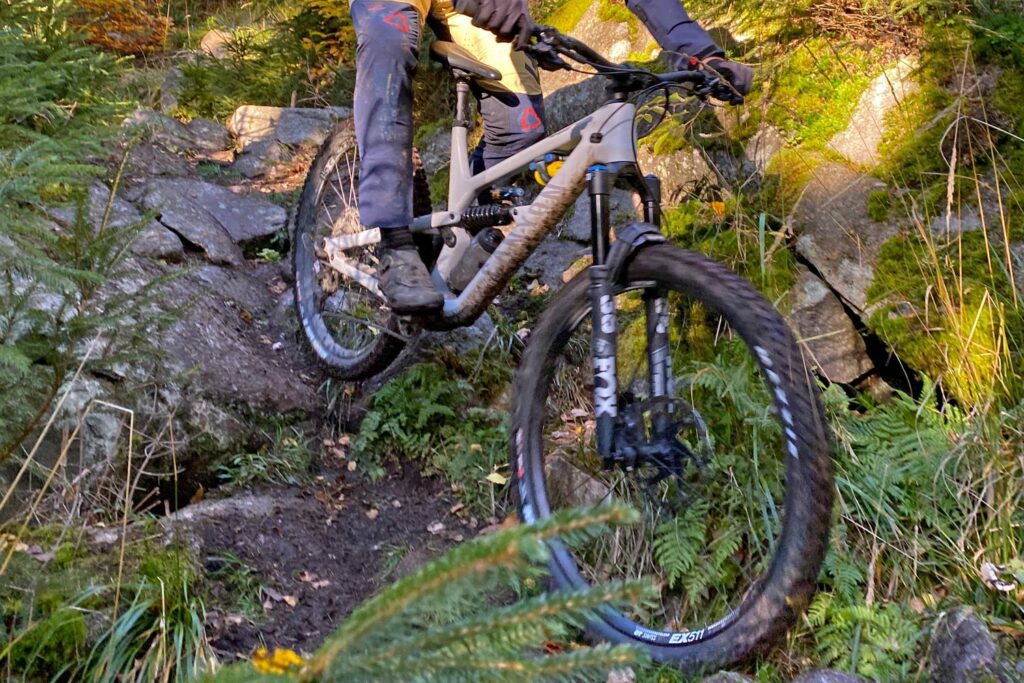


“Rocks, roots, and other challenges may obstruct your path, but they also present opportunities for growth. Embrace them as stepping stones to success, for it is through overcoming obstacles that we truly shine as mountain bikers.”
Mountain biking is all about overcoming the obstacles that nature presents to you. Rocks, roots, logs, and other trail features can present challenges, but with the right technique and skills, you can traverse them with confidence.
Here is a complete guide to help you overcome obstacles on your mountain bike:
Approach and Assessment:
Look Ahead:
Scan the lane for upcoming obstacles and plan line selection.
Obstacle Assessment:
Assess the size, shape, and potential for danger. Determine the best approach to maintain control and momentum.
Body Position:
Brace yourself:
Adopt a neutral riding position with your knees and elbows bent and your body weight on the bike.
Keep your balance:
Shift your weight back and down slightly when approaching obstacles to improve your balance.
Techniques for Rocks and Roots:
Lift the front wheel:
Approach an obstacle at a reasonable speed and, when you reach it, lift the front wheel by pressing down on the handlebars and simultaneously shifting your weight backward.
Reduce the load on the rear wheels:
When the front wheels roll over an obstacle, shift your weight forward and quickly lift the rear wheels by spreading your legs.
Smooth and Controlled:
Aim to roll over obstacles in one smooth motion by gently gripping the handlebars and letting your bike’s suspension soak up the bump.
Journals and Publishing Techniques:
Approach with speed and confidence:
Maintain your momentum to overcome larger obstacles such as small logs and cliffs.
Drop the Weights and Jump:
Just before hitting an obstacle, squeeze your body and bike together to offload the load from both wheels, then explosively lift your legs to jump over them.
Absorb the landing:
When landing, bend your knees to absorb the impact while maintaining control and balance.
Practice and progress:
Start with smaller obstacles:
Start practicing on smaller rocks, roots, and logs before moving on to bigger challenges.
Gradually Increase Difficulty:
Look for increasingly difficult obstacles to further develop your skills while building your confidence and skills.
Mastering obstacle negotiation techniques improve your ability to navigate technical terrain with confidence and control. This allows you to maintain momentum, conserve energy, and ride on more demanding trails.
Always remember to prioritize safety, wear protective gear, and train on trails appropriate for your skill level. By constantly improving your ability to handle obstacles, you’ll open up new possibilities and enjoy a more rewarding and exciting mountain biking experience.
Read More : ” Can You Ride A Mountain Bike On Beach? “
Practice and progress: hone your skills and gain experience
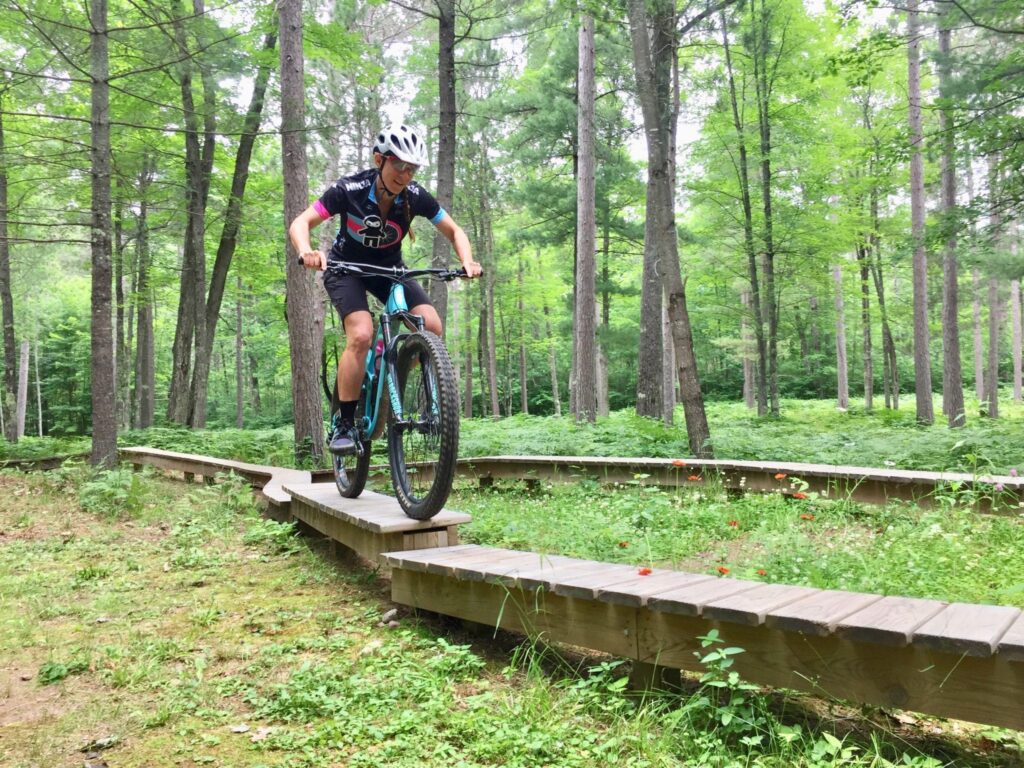


“Practice is the key to progress in mountain biking. With each ride, you push your limits, refine your techniques, and gain invaluable experience. Embrace the journey, for it is through dedication and perseverance that you become a better rider.”
When it comes to mountain biking, it’s important to practice and progress to become a competent and confident cyclist. As a beginner, you must take the time to hone your skills, gain experience and continue to grow in your mountain bike journey.
Here’s a comprehensive guide to help you understand the importance of practice and progress:
Start with the basics:
Cycling skills:
Focus on basic techniques such as body position, braking, shifting, and cornering.
Stability and Control:
Practice keeping your balance while driving at different speeds and over different terrain.
Pedal Efficiency:
Serves to develop a smooth pedaling action and find the right cadence for different riding conditions.
Consistent practice:
Drive regularly:
Try to drive regularly, even for short periods. This helps build muscle memory and reinforces proper technique.
Skill-specific drills:
Set aside targeted sessions to practice specific skills or techniques, such as turning corners or overcoming obstacles.
Progressive Challenges:
Gradually increase the difficulty of your ride by tackling more technical terrain and exploring the different track features.
Get advice and training:
Professional Training:
Consider taking a class or going to a clinic to learn from an experienced rider or certified instructor.
Group Trips:
Join group trips or local cycling communities to learn from others, and get ideas and feedback on your cycling technique.
Push your limits with confidence:
Progressive Mindset:
Set achievable goals and gradually step out of your comfort zone to develop your skills and confidence.
Progressive Track Difficulty:
Gradually advance from easier to more difficult trails, allowing you to adapt to the demands of the technical terrain.
Learn from your mistakes:
Challenge yourself:
Don’t let setbacks or mistakes discourage you. Learn from them and use them as opportunities to grow and develop.
Analyze and Adjust:
Reflect on your run and identify areas where you can make changes or improvements in your technique.
By spending time practicing and progressing, you will build a solid skill base, gain valuable experience, and improve your overall mountain biking skills.
Remember that progress is a personal journey and everyone learns at their own pace. Be patient, stay motivated, and celebrate your progress along the way. By continuing to train and commit to improving yourself, you will unlock new levels of fun and satisfaction in your mountain biking adventures.
Conclusion:
Therefore, learning how to ride a mountain bike for beginners requires a systematic approach and dedication. Beginners can hone their skills and gain confidence on the trail by understanding the importance of bike setup, body position, braking and shifting, pedaling technique, trail awareness, turns, overcoming obstacles, and constant practice.
Mastering the basics is the key to building a strong foundation. Take the time to properly tune your bike, ensuring a comfortable fit and optimal performance. Focus on maintaining proper body position to improve balance and control.
Learn how to effectively use the brakes and gear changes for a smooth and efficient ride.
Developing a pedaling technique that maximizes power and pace will help you conquer any terrain. Trail knowledge is key to reading the terrain and choosing the best route. Safe cornering requires mastery of techniques such as weight distribution and leaning into turns.
Overcoming obstacles such as rocks and roots requires concentration and skill. Remember to start small and progress gradually as you gain experience and confidence. Train regularly and look for opportunities to grow through group outings, skills clinics, or guided training.
Beginners can enjoy an exciting mountain biking experience and continually improve their skills by following these steps and practicing constantly. Go on a learning journey, stay motivated, and always put safety first.
With time and dedication, you will become a competent and confident mountain biker. So grab your bike, apply these principles, and enjoy the thrilling adventure of beginner-level mountain biking.
FAQs:
How do you mountain bike for the first time?
When mountain biking for the first time, start with proper gear, learn basic techniques, practice balance and control, and gradually increase difficulty. Enjoy the thrilling adventure on the trails!
Are mountain bikes easy to ride?
While mountain biking requires some skill and practice, it can be learned by beginners. With the right techniques and gradual progression, anyone can enjoy the excitement of riding a mountain bike.
Is mountain bike riding hard?
Mountain bike riding can be challenging, especially for beginners, as it requires balance, endurance, and technical skills. However, with practice and proper guidance, riders can overcome difficulties and enjoy the thrill of the sport.
How do I prepare for my first bike ride?
To prepare for your first bike ride, ensure your bike is in good condition, wear appropriate gear, plan your route, bring essentials like water and snacks, and start with shorter, easier rides to build confidence.
Does mountain biking burn fat?
Yes, mountain biking can be an effective way to burn fat as it is a high-intensity cardiovascular exercise that engages multiple muscle groups and increases your heart rate.



Welcome to Bikegenics, where passion meets performance! We are a leading online destination for all things related to mountain biking, dedicated to providing you with top-notch gear, expert advice, and an immersive community to fuel your two-wheeled adventures. With a commitment to excellence and a deep love for the sport, we strive to elevate your biking experience to new heights.
